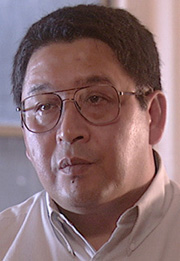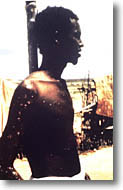Smallpox: The Weapon
 The beautiful New England town of Amherst, Massachusetts is home to many well known colleges and universities. Amherst College, for one, is an ivy league school that has educated may of America's most brilliant leaders and scientists. Named for Lord Jeffrey Amherst, most students and residents know little about the namesake of their school and town, other than his office as the British commander-in-chief for America, prior to America's independence. They do not know that Amherst was responsible for the first recorded use of smallpox as a weapon.
The beautiful New England town of Amherst, Massachusetts is home to many well known colleges and universities. Amherst College, for one, is an ivy league school that has educated may of America's most brilliant leaders and scientists. Named for Lord Jeffrey Amherst, most students and residents know little about the namesake of their school and town, other than his office as the British commander-in-chief for America, prior to America's independence. They do not know that Amherst was responsible for the first recorded use of smallpox as a weapon.
Jeffrey Amherst's name has become tarnished by stories of smallpox-infected blankets used as germ warfare against American Indians. In Carl Waldman's Atlas of the North American Indian [NY: Facts on File, 1985], Waldman writes, in reference to a siege of Fort Pitt (Pittsburgh) by Chief Pontiac's forces during the summer of 1763:
... Lord Jeffrey Amherst, the British commander-in-chief for America, believed ... that the best way to control Indians was through a system of strict regulations and punishment when necessary, not "bribery," as he called the granting of provisions. [p. 106]
... Captain Simeon Ecuyer had bought time by sending smallpox-infected blankets and handkerchiefs to the Indians surrounding the fort -- an early example of biological warfare -- which started an epidemic among them. Amherst himself had encouraged this tactic in a letter to Ecuyer. [p. 108]
An additional source of information on the matter is the Journal of William Trent, commander of the local militia of the townspeople of Pittsburgh during Pontiac's siege of the fort. This Journal has been described as "... the most detailed contemporary account of the anxious days and nights in the beleaguered stronghold." [Pen Pictures of Early Western Pennsylvania, John W. Harpster, ed. (University of Pittsburgh Press, 1938).]
Trent's entry for May 24, 1763, includes the following statement:
... we gave them two Blankets and an Handkerchief out of the Small Pox Hospital. I hope it will have the desired effect.
The American Revolutionary War
It has been alleged that smallpox was also used as a weapon during the American Revolutionary War (1775-83). During the winter of 1775-76, American forces were attempting to free Quebec from British control. After capturing Montréal, it looked as if they might succeed. But in December 1775, the British fort commander reportedly had civilians immunized against the disease and then deliberately sent out to infect the American troops. A few weeks later a major smallpox epidemic broke out in the American ranks, affecting about half of the 10,000 soldiers. They retreated in chaos after burying their dead in mass graves.
World War Two and after
During World War Two, British and American scientists investigated using smallpox as a biological weapon. However, because of the availability of vaccine, they never felt it was a particularly effective weapon. In November 1969, President Nixon officially halted the US offensive biological weapons program, bowing to pressure from the American public who had been abhorred by the use of chemical weapons during the Vietnam War.
The US believed initially that, like them, the Soviet Union had done away with its bioweapons program. However, it had miscalculated.
In the wake of Nixon's historic abandonment of biological weapons, an international agreement was tabled outlawing their development and production altogether. In 1972, the United Kingdom, the United States and the Soviet Union all signed up to the Biological Weapons Convention. But adherence to the Convention was short-lived.
In 1992, a Soviet defector revealed to Western intelligence that he had overseen an extensive, illegal program to develop smallpox into a highly effective biological weapon.
Britain and the United States were shocked by the revelations. Russia's intent to use biological weapons, they claimed, was morally abhorrent.
Vladimir Pasechnik (who died in November 2001, aged 64) asserted that far from abandoning its bio-weapons program, the Soviet Union had intensified it. He revealed that the civilian pharmaceutical company, 'Biopreparat', which the Soviets had established in 1973, was in fact a front for a massive offensive bio-weapons program.
 There were more bombshells to come. Dr. Kanatjan Alibekov [right], or Ken Alibek as he is now known, was Chief Scientist at Biopreparat from 1987 to 1992. Ken Alibek's bosses told him that the Americans and British had not given up on biological weapons and were still engaged in their own offensive programs. He felt his work was justified on these grounds.
There were more bombshells to come. Dr. Kanatjan Alibekov [right], or Ken Alibek as he is now known, was Chief Scientist at Biopreparat from 1987 to 1992. Ken Alibek's bosses told him that the Americans and British had not given up on biological weapons and were still engaged in their own offensive programs. He felt his work was justified on these grounds.
Ken Alibek started to find discrepancies in the KGB's information and began to have doubts. In December 1991, in exchange for US/UK inspections of a number of Soviet laboratories, a team of Soviet officials was invited to inspect four US facilities. This trip cemented Alibek's concerns.
A real turning point was when I came to the US and I saw all the so called BW [biowarfare] facilities, completely abandoned, not active. I was shocked.
Alibek defected to America in October 1992 and spent much of the next year being debriefed by CIA officers. His most startling revelation concerned smallpox. He told them how, during the global campaign to eradicate the disease, samples of smallpox taken by Russian doctors had been turned into weapons by the Soviet military. DA Henderson, who led the eradication campaign, felt particularly betrayed by this.
The Russians themselves had proposed the global eradication program back in 1958. They had pledged to provide 25 million doses of vaccine every year to the program. If we hadn't had that amount of vaccine we could never have succeeded. [Henderson]
Alibek claims the Kremlin had a clear understanding that if smallpox was believed to have been eradicated, and vaccination ended, the virus had the potential to be
the most powerful and effective weapon ever created to eliminate human life.
According to Alibek, one particularly virulent strain, India 67 or India 1, was chosen by the Russians to be weaponized. They perfected techniques for mass producing smallpox and maintained a rolling annual stockpile of hundreds of tons. They also developed ways to disseminate the virus in aerial bombs and ballistic missile warheads. Additional work was done to enhance the virulence of the virus and to combine it with other viruses.
Alibek believes that, following the collapse of the Soviet Union in 1991, unemployed or badly-paid scientists are likely to have sold samples of smallpox clandestinely and gone to work in rogue states engaged in illicit biological weapons development. DA Henderson agrees that this is a plausible scenario and is upset by the legacy it leaves.
If the [Russian bio weapons] program had not taken place we would not I think be worrying about smallpox in the same way. One can feel extremely bitter and extremely angry about this because I think they've subjected the entire world to a risk which was totally unnecessary. [Henderson]
But is this the only source of the virus?
Unrecorded samples left over from the time when the disease was endemic may still exist in other countries. In 1984, when the world's remaining smallpox samples were moved to two high security laboratories in Russia and America, no inspections were carried out to verify that other countries had destroyed their stocks of the virus. As Henderson says, it would have been an impossible task to try to identify what there might be in anybody's deep freeze is a real problem.
There is no hard evidence, but in Alibek's opinion, there are many non-official stocks of smallpox virus. Western intelligence agencies also believe, based on circumstantial and anecdotal evidence, that three countries - North Korea, Iraq and Russia - currently have the capacity to deploy smallpox as a weapon of mass destruction. Other countries that are suspected of having inadvertently or deliberately retained specimens of the virus include China, Cuba, India, Iran, Israel, Pakistan and Yugoslavia.
It is difficult to assess the real nature of the threat from smallpox from this evidence. Why anyone would wish to use a disease which could lead to the indiscriminate killing of millions as a weapon is difficult to gauge.



 The beautiful New England town of Amherst, Massachusetts is home to many well known colleges and universities. Amherst College, for one, is an ivy league school that has educated may of America's most brilliant leaders and scientists. Named for Lord Jeffrey Amherst, most students and residents know little about the namesake of their school and town, other than his office as the British commander-in-chief for America, prior to America's independence. They do not know that Amherst was responsible for the first recorded use of smallpox as a weapon.
The beautiful New England town of Amherst, Massachusetts is home to many well known colleges and universities. Amherst College, for one, is an ivy league school that has educated may of America's most brilliant leaders and scientists. Named for Lord Jeffrey Amherst, most students and residents know little about the namesake of their school and town, other than his office as the British commander-in-chief for America, prior to America's independence. They do not know that Amherst was responsible for the first recorded use of smallpox as a weapon. There were more bombshells to come. Dr. Kanatjan Alibekov [right], or Ken Alibek as he is now known, was Chief Scientist at Biopreparat from 1987 to 1992. Ken Alibek's bosses told him that the Americans and British had not given up on biological weapons and were still engaged in their own offensive programs. He felt his work was justified on these grounds.
There were more bombshells to come. Dr. Kanatjan Alibekov [right], or Ken Alibek as he is now known, was Chief Scientist at Biopreparat from 1987 to 1992. Ken Alibek's bosses told him that the Americans and British had not given up on biological weapons and were still engaged in their own offensive programs. He felt his work was justified on these grounds.